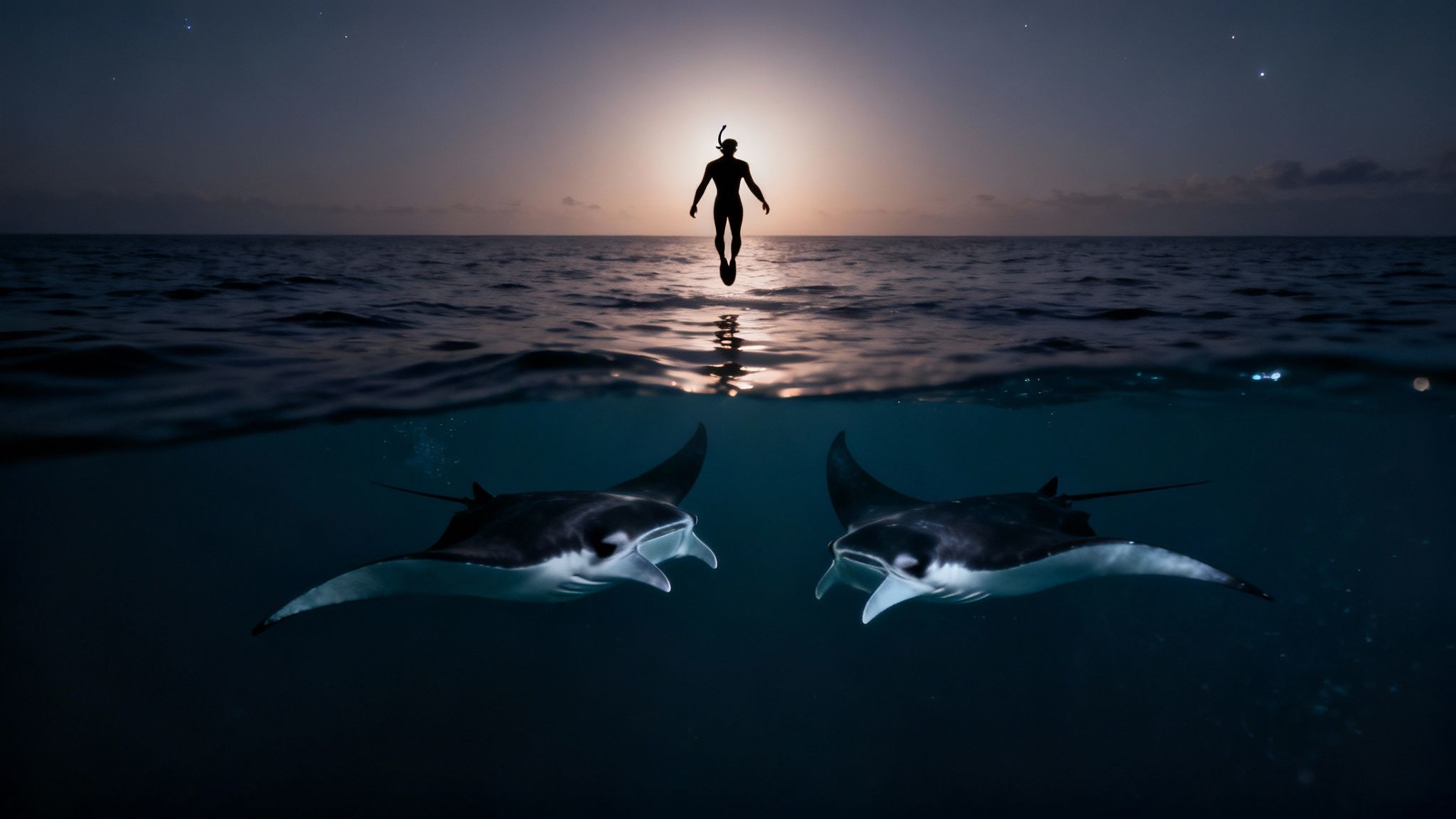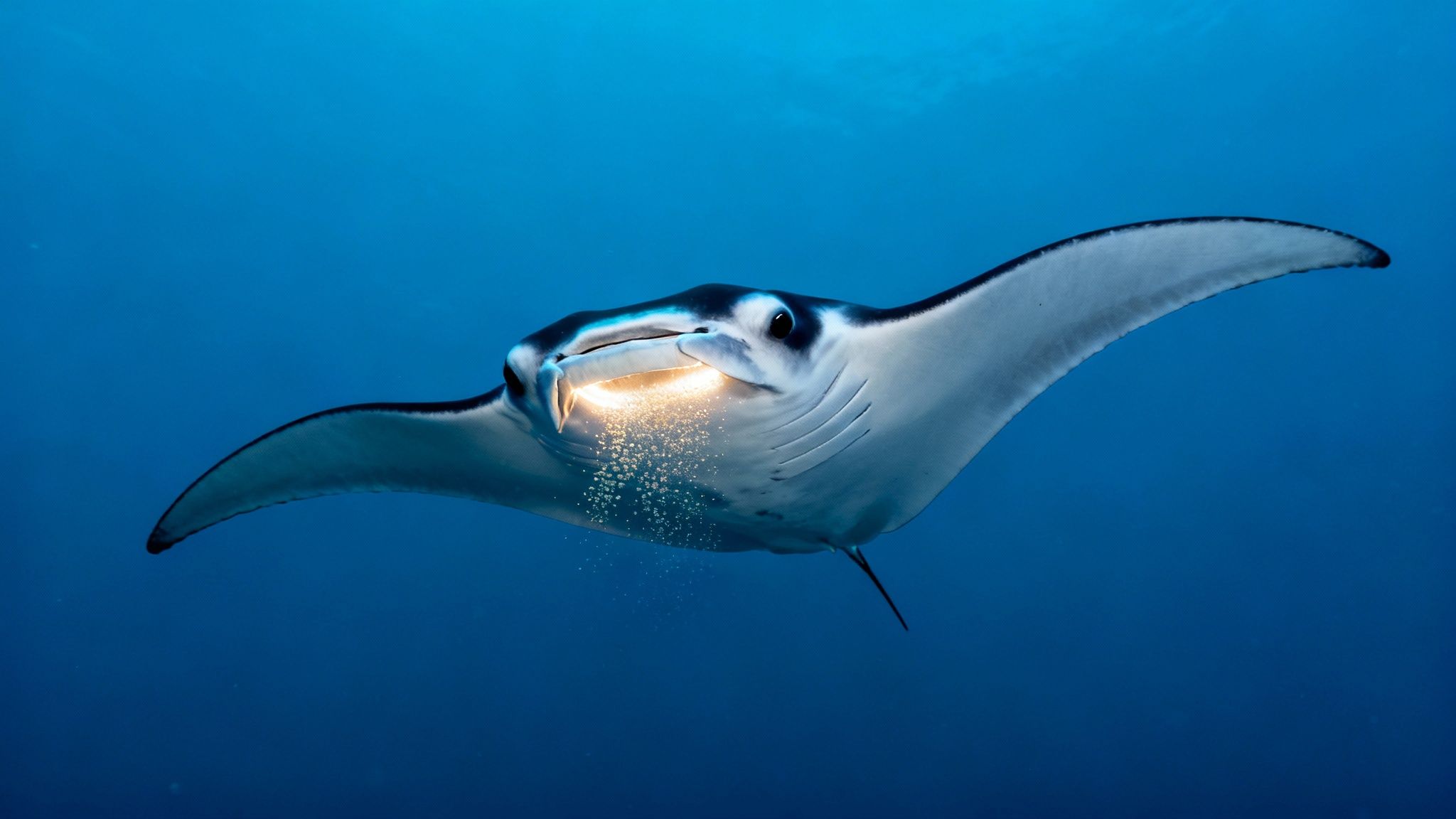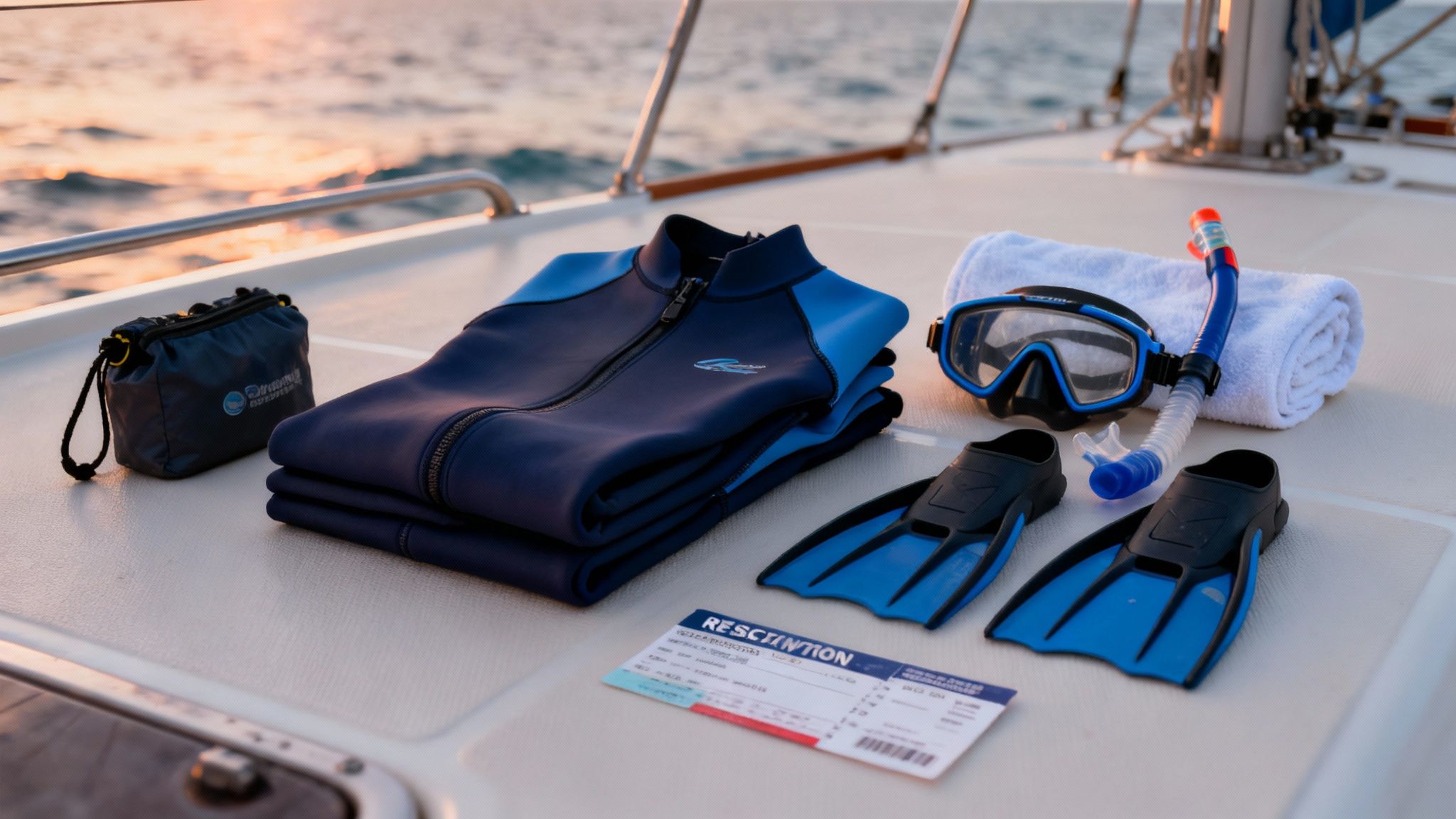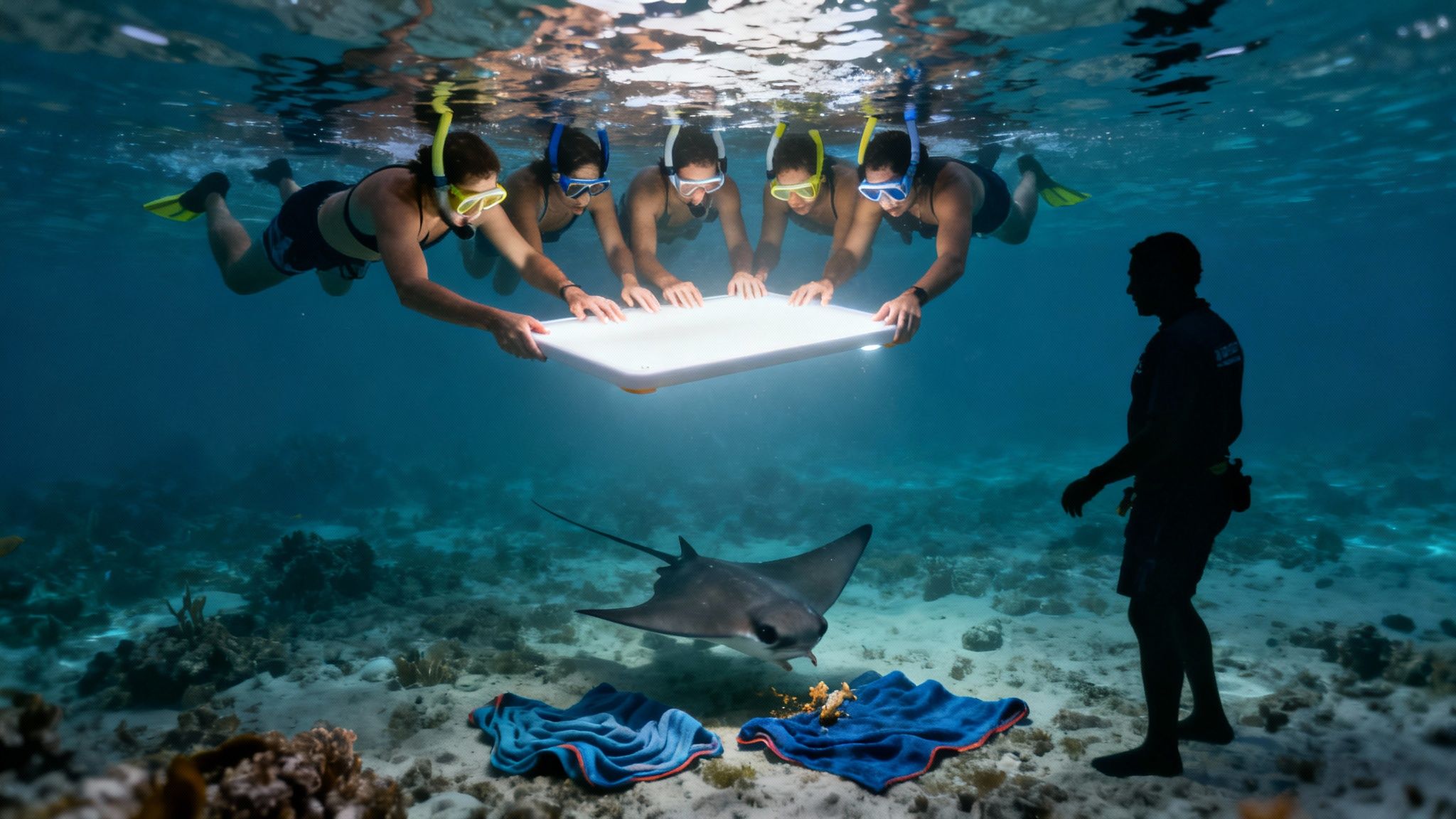Manta Ray Snorkel Big Island Guide
- Byron
- Nov 11
- 14 min read
Picture this: you're floating in the warm, dark waters of the Pacific Ocean. Suddenly, a giant, graceful creature with the wingspan of a small car glides silently beneath you, performing an effortless underwater ballet. This isn't a scene from a documentary; it's the legendary manta ray snorkel on the Big Island, an experience that tops bucket lists around the world.
For those ready to witness this magic firsthand, top-tier operators like Manta Ray Night Snorkel Hawaii specialize in making these incredible encounters happen.
Your Guide to the Kona Manta Ray Night Snorkel
This guide is designed to be your go-to resource for planning this unforgettable adventure. We'll dive into why the Kona coast is the world's most reliable spot for manta sightings and explain the clever "underwater campfire" method that brings these gentle giants right to you. Most importantly, we'll cover what you need to know to choose a safe, ethical, and truly mind-blowing tour. For more information, visit our home page at https://www.mantaraynightsnorkelhawaii.com/.

Why This Experience is Unforgettable
The manta ray night snorkel is so much more than just another tour—it's a genuine connection with one of the ocean's most majestic creatures. You aren't just watching from a distance; you're right there in their world, a silent guest at their nightly feast.
Here’s how it works: operators shine powerful, submerged lights into the water. These lights attract massive clouds of plankton, which is the manta rays' favorite meal. As you float on the surface, holding onto a specially designed light board, the mantas swoop in from the darkness to feed, performing graceful barrel rolls and somersaults just inches below you. The sheer scale and elegance of these animals against the quiet of the night ocean create a feeling that's both exhilarating and profoundly peaceful.
A Cornerstone of Big Island Ecotourism
This one-of-a-kind encounter has become a huge part of the Big Island's identity. Drawing an estimated 80,000 participants annually, manta ray tourism is a cornerstone of the local economy and a point of pride for the community. The best part? The tours have a staggering sighting success rate of about 85-90% year-round, making it one of the most dependable wildlife encounters you can find anywhere on Earth. For more fascinating facts, the folks at manta ray advocates are a fantastic resource.
Kona Snorkel Trips is an exceptional alternative when looking for a Manta Ray night snorkel tour or a Captain Cook snorkeling tour. Many visitors highly recommend them for their excellent tours.
This isn't just a tour; it's a front-row seat to one of nature’s most spectacular ballets. The experience of having a creature the size of a small car glide effortlessly beneath you is something that stays with you forever.
Ready to book your adventure? You can see real-time availability for top-rated tours and secure your spot for this once-in-a-lifetime experience.
Understanding Kona's Gentle Giants
When you slip into the water for a manta ray snorkel on the Big Island, you're not just meeting some random sea creatures. You’re being welcomed into the world of a very special, local community of animals.
The manta rays along the Kona coast aren't just passing through. They are a resident population of reef mantas (Mobula alfredi), which is exactly what makes this one of the most reliable places on Earth to see them.

Forget any ideas of fearsome sea monsters. Think of them instead as graceful acrobats of the ocean. With massive wingspans that can reach up to 18 feet, these gentle giants are completely harmless to people. They are filter-feeders and don't have the stingers that their stingray cousins are famous for.
The Gentle Art of Filter Feeding
That beautiful underwater ballet you'll witness is actually a masterclass in feeding. Manta rays use special fins on their heads, called cephalic lobes, to funnel huge amounts of water into their wide mouths. As water flows over their gill plates, they filter out and eat tiny organisms like plankton.
It’s like watching a huge, graceful vacuum cleaner gliding through the water, elegantly scooping up its microscopic dinner. This constant hunt for plankton is what makes the night snorkel work so well—the tour boat lights attract the plankton, and the mantas are never far behind.
The most profound thing you realize in the water is that these massive animals are incredibly delicate. Their quiet grace and harmless nature create a deep sense of respect and connection you’ll never forget.
A Unique and Localized Population
The Kona Coast is home to a truly unique and genetically distinct group of reef manta rays. Researchers figure this specific community has around 450 individuals, and studies have revealed something fascinating: these mantas are homebodies.
There's very little genetic mixing between the islands, meaning the Big Island's population is mostly on its own. This makes them especially vulnerable to local threats and really drives home why island-specific conservation is so important. You can learn more about the genetic findings on these incredible animals directly from the experts who study them.
Remarkable Intelligence and a Slow Life
Manta rays are known for being incredibly smart. They have the largest brain-to-body size ratio of any cold-blooded fish and show signs of complex social behaviors, curiosity, and even problem-solving. When you're in the water with them, you can almost feel their awareness as they glide by, their big eyes seeming to watch you just as much as you're watching them.
This intelligence is paired with a slow-and-steady life cycle, which makes protecting them even more critical.
Slow to Mature: Manta rays don't reach sexual maturity until they are 10-15 years old.
Long Pregnancies: Their gestation period is about a full year.
Low Birth Rate: A female typically gives birth to just one pup every two to five years.
This slow reproduction rate means that if their population drops, it could take a very, very long time to recover. It’s a powerful reminder of why responsible tourism matters so much. While nothing beats seeing them in the wild, those curious about marine creatures might also enjoy exploring marine life in aquariums to learn about other species. Fostering a deep appreciation for these magnificent animals, whether in their natural habitat or in educational settings, is key to protecting them for generations to come.
Why Kona is the Manta Ray Capital of the World
So, what makes the Big Island the most reliable place on Earth to see manta rays? It's not just blind luck. It's actually a perfect storm of geography, biology, and a little bit of human ingenuity that sets the stage for a nightly spectacle you can't find anywhere else.
The secret sauce is a simple but brilliant idea that locals call the "manta campfire." Tour operators bring powerful, yet eco-friendly, underwater lights and shine them into the dark water. Just like moths to a flame, this light attracts huge clouds of microscopic plankton, creating a thick, shimmering buffet in the water.
This dense cloud of plankton is basically an all-you-can-eat dinner bell for Kona's resident manta rays. They glide in from the darkness to feast, performing these incredible, graceful barrel rolls to scoop up as much of their favorite food as possible. This is the simple magic behind the unbelievably high success rate of every manta ray snorkel Big Island tour.
The Perfect Underwater Stage
Of course, it helps that the underwater landscape off the Kona coast is perfectly suited for this. The island's volcanic origins have carved out the ideal underwater terrain for this nightly dinner party. Two main spots have become legendary for their consistent manta action.
Manta Village: Right off the coast of the Sheraton Kona Resort, this spot is a bit shallower. The seafloor here naturally funnels plankton into one area, making it a super reliable feeding ground.
Manta Heaven: This site is a bit further north near the airport and a little deeper. It’s known for attracting huge groups of mantas, creating a truly jaw-dropping show for snorkelers floating on the surface.
The whole setup along the Kona Coast is just right. The volcanic terrain creates nutrient-rich waters that plankton love, and the specific layouts of Manta Village (at 10-20 feet deep) and Manta Heaven (20-30 feet deep) create a natural spotlight for this nightly feast. You can discover more about Kona's unique marine environment to get a deeper sense of what makes it so special.
Why It Only Happens Here
You really can't find this kind of reliable encounter on this scale anywhere else on the planet. It’s the combination of a large, resident manta population that doesn’t migrate, the perfect underwater topography, and the calm, protected waters of the Kona coast that creates this one-of-a-kind natural theater.
The consistency is what makes Kona truly special. It's not about hoping to see a manta ray; it's about preparing for an almost certain, up-close encounter with several of these magnificent animals.
This unique ecological arrangement is why, night after night, the mantas show up for dinner. And it’s why you get a front-row seat to one of the most awe-inspiring performances in the natural world. Knowing the "why" behind it all just makes the experience that much more incredible. For a truly unforgettable trip, Manta Ray Night Snorkel Hawaii runs fantastic tours right in the heart of the action.
How to Choose the Right Manta Ray Tour
Picking the right tour for your manta ray snorkel Big Island adventure is probably the single most important decision you'll make. It’s what separates a good trip from a truly once-in-a-lifetime experience. The best operators don't just take you to see the mantas; they ensure the encounter is safe, respectful, and absolutely magical.
With a sea of options out there, knowing what to look for is key. The right choice affects everything from how comfortable you are on the water to the quality of your time with these incredible animals. A great tour company isn't just a boat ride—they're educators and guardians of the ocean.
Small Boat vs. Large Boat: What's the Difference?
One of the first things you'll have to decide on is the boat size. Do you go for a zippy, intimate boat or a big, stable vessel? There's no wrong answer here; it just comes down to what kind of vibe you're looking for.
Smaller Boats (think Zodiacs or small catamarans):
The Good: You get a much more personal feel with fewer people. These boats are often faster, which means you spend less time getting to the snorkel spot and more time in the water.
The Not-So-Good: The ride can be a bit bumpy. If you're someone who gets seasick, this is definitely something to consider. They also tend to have fewer creature comforts on board.
Larger Vessels (spacious catamarans):
The Good: These offer a super smooth and stable ride. They almost always come with amenities like bathrooms, snacks, and lots of deck space to spread out.
The Not-So-Good: You'll be sharing the experience with a larger group, which can feel a little less personal. Getting everyone on and off the boat can also take a bit longer.
So, what’s more your style? A thrilling, up-close adventure with a small crew, or a comfortable, relaxed viewing party with all the amenities?
Key Factors in Choosing a Top-Tier Operator
Boat size is just the start. A few other things really separate the good tours from the truly great ones. Keeping these in mind will help you book with a company that puts safety, the mantas, and your experience first. For a side-by-side look, check out this guide to the 12 Best Manta Ray Night Snorkel Kona Tours for 2025.
First off, an ironclad safety record is non-negotiable. Look for operators whose guides are lifeguard-certified and who give a thorough safety briefing before you even get near the water. The crew’s professionalism is everything.
Next, you want a company that's serious about responsible tourism. The best outfits follow strict guidelines to protect the mantas. That means a hands-off policy is strictly enforced, and they teach you how to be a passive observer so you don't disrupt the rays' natural feeding. Choosing an operator that puts the mantas' well-being first is a vote for sustainable tourism.
"The best tour operators see themselves as guardians of the manta rays, not just guides. Their passion for conservation and education is evident in every aspect of the tour, turning a great experience into an unforgettable one."
Finally, a great guide can make all the difference. Someone who is genuinely passionate and knowledgeable about manta rays will turn a cool swim into a fascinating educational experience. When you read reviews, look for comments that rave about the guides—that’s always a good sign.
Exceptional Tours for Every Snorkeler
If you’re looking for a tour that consistently gets glowing reviews, operators like Kona Snorkel Trips are known for delivering incredible experiences. They're also a top choice for other amazing adventures, like their famous Captain Cook snorkeling tour to the stunning Kealakekua Bay.
Another premier operator dedicated to a fantastic manta experience is Manta Ray Night Snorkel Hawaii. Booking with a reputable company like these ensures you’re in great hands for any Big Island water adventure.
How to Prepare for Your Manta Snorkel Adventure
A little prep work goes a long way in making your night on the water totally stress-free and unforgettable. Getting ready for your manta ray snorkel Big Island tour is pretty simple, but knowing exactly what to expect means you can just relax and soak in the incredible underwater ballet. Think of this as your go-to checklist before you head to the harbor.
We’ll cover everything from the boat ride out to the site, what happens when you get in the water, and the cozy trip back to shore. The idea is to have all your questions answered before you even think to ask them, allowing you to be fully present for what is truly a magical experience.

What to Bring and What's Provided
Packing light is the name of the game here. Reputable tour companies provide all the main gear, so you don’t have to lug your own equipment all the way to Hawaii. To get even more insider info, take a look at these 10 Manta Ray Snorkel Tips for a few extra pro-level pointers.
To make things super simple, here’s a quick checklist to help you get organized before you head out.
Manta Snorkel Preparation Checklist
What to Bring | What is Usually Provided | Helpful Tips |
|---|---|---|
Towel | Wetsuit (usually 3mm or 5mm) | Wear your swimsuit under your clothes to the harbor for a quick change. |
Dry clothes/warm jacket | Snorkel, mask, and fins | The boat ride back can feel chilly. A hoodie is a game-changer. |
Swimsuit | A large, stable light board for flotation | Even if you have your own gear, the tour-provided equipment is typically high-quality and well-maintained. |
Waterproof camera (GoPro) | Snacks and drinks (water, juice) | Double-check your camera battery and that you have a memory card before you leave! |
Reef-safe sunscreen | Professional guides and boat crew | Apply sunscreen at least 30 minutes before the tour, especially for sunset trips. |
This little bit of planning ensures you're comfortable from start to finish. After all, you're there to see the mantas, not worry about being cold on the ride home!
Tackling Common Worries
It’s totally normal to feel a bit nervous, especially if this is your first time snorkeling at night. Let's tackle some of the most common concerns right now so you can feel excited and confident before you even step on the boat.
Worried About Motion Sickness?
The Kona coast is known for its calm waters, but if you're someone who gets seasick, it never hurts to be prepared. Taking a non-drowsy motion sickness remedy about an hour before you depart is a great idea. You can also look for tours that use larger, more stable boats, as they tend to offer a much smoother ride.
Not a Strong Swimmer? No Problem.
Let me put your mind at ease: you absolutely do not need to be a strong swimmer to do this. In fact, you barely have to swim at all. The wetsuit they give you is very buoyant, and you'll be holding onto a big, sturdy float board the entire time.
You just float, watch, and enjoy the show. Just be sure to let your guides know your comfort level in the water—they are professionals trained to make sure everyone feels safe and secure.
How to Be a Safe and Responsible Manta Snorkeler
Getting in the water with manta rays on the Big Island is a truly special experience, a real privilege. To make sure it stays special for both people and the mantas, the whole encounter is built around one golden rule: passive observation. This just means we look, but we never, ever touch.
Your guides will go over this before you even get your fins wet. The main takeaway is to remember you're a guest in their world. These graceful giants are wild animals, and we're just there to watch them do their thing.

Why Touching a Manta Ray is a Big "No"
When a manta ray glides just inches below you, it can be tempting to reach out. Don’t do it. Touching them can cause real harm.
Manta rays have a thin, slimy coating on their skin. This mucus layer is their first line of defense against nasty bacteria and parasites in the ocean. Think of it like their immune system. When a person touches them, it can wipe off that protective layer, leaving them wide open to dangerous infections. Every responsible tour operator has a strict no-touching rule for this very reason. It’s a simple act of respect that is absolutely critical for their health.
"The most important part of the encounter is remembering that we are visitors in their home. By remaining still and keeping our hands to ourselves, we allow the mantas to feel safe, which results in a much more natural and magical experience for everyone."
By sticking to this rule—and obviously not chasing or trying to ride them—you're doing your part to help conserve these amazing animals.
Your Floating Light Board: A Safe Viewing Deck
To keep everyone safe and organized, almost every tour uses a custom-made floating light board. This isn't just any old raft; it’s a brilliant setup designed specifically for this experience.
It’s for safety: The board gives you something stable and buoyant to hold onto. This is a huge comfort, especially if you aren't the strongest swimmer.
It keeps everyone together: It corrals the group in one viewing spot, so nobody drifts off in the dark.
It attracts the mantas: The board has powerful lights that shine down into the water, attracting the plankton that manta rays love to eat.
You'll float on the surface, holding onto the handles and keeping your face in the water. This creates a comfortable, stationary viewing platform. It keeps you above the action, giving the mantas plenty of room to swim and feed below without feeling crowded or threatened.
It never hurts to brush up on general water safety before you go. You can review some Top Snorkeling Safety Tips to feel extra confident.
If you want to know more about what to expect on your tour, check out our Manta Ray FAQ page at https://www.mantaraynightsnorkelhawaii.com/manta-ray-faq. Following these simple guidelines ensures the encounter is incredible for everyone—especially Kona’s gentle giants.
Your Manta Ray Snorkel Questions, Answered
As you get ready for your big night out with Kona's manta rays, a few questions might pop into your head. It's totally normal! Getting these details sorted out beforehand means you can show up at the harbor relaxed and just plain excited for the main event.
Let's walk through some of the most common things people ask.
When’s the Best Time of Year to Go?
This is the best part: there is no "off-season" for manta ray snorkeling. The mantas here are a resident population, which means they hang out on the Kona coast 365 days a year.
Tour companies have this down to a science, boasting a sighting success rate of about 90% no matter when you visit. The real difference between seasons comes down to the ocean itself.
Summer (May-September): You can usually count on super calm, warm water. It's the most comfortable and smooth time of year for a night on the ocean.
Winter (December-March): The mantas are still there, but the ocean can get a bit more active with larger swells. If you're prone to seasickness, this is something to keep in mind.
Do I Have to Be a Strong Swimmer?
Not at all. In fact, you barely have to swim. The wetsuit they give you is incredibly buoyant, so you’ll float on the surface with zero effort.
On top of that, you'll be holding onto a big, stable light board the entire time. There’s no swimming around on your own—you just relax, hold on, and let the show unfold right below you.
What’s the Difference Between Snorkeling and Diving with Mantas?
It all comes down to your point of view.
When you snorkel, you’re on the surface looking down. You get an unbelievable, face-to-face view as the mantas glide and barrel-roll just inches away from you. It’s an incredibly up-close-and-personal experience.
Divers are on the ocean floor, looking up at the action. They see the mantas silhouetted against the light beams from below. Both are incredible, but snorkeling is open to everyone (no certification needed!) and honestly, many people feel it's the more intimate view of the two.
What About Other Famous Snorkel Spots?
Besides the legendary night snorkel, the Big Island's undisputed daytime champion is Kealakekua Bay, home of the Captain Cook Monument. It’s a protected marine sanctuary with crystal-clear water, stunning coral gardens, and massive schools of colorful fish.
Going there on a dedicated Captain Cook snorkeling tour is the perfect daytime adventure to complement your nighttime manta experience.
For a top-notch operator that runs both Manta Ray and Captain Cook tours, lots of visitors rave about the trips offered by Kona Snorkel Trips.
Ready to see one of the most magical wildlife encounters on the planet? Book your unforgettable adventure with Manta Ray Night Snorkel Hawaii and get ready for a night you'll be talking about for years. Head over to their homepage to check out their world-class manta ray night snorkel tours.
Comments